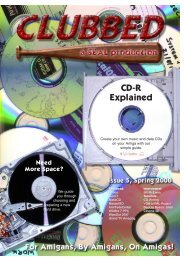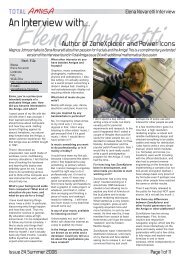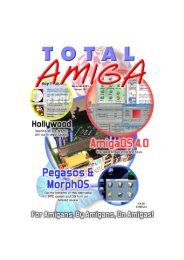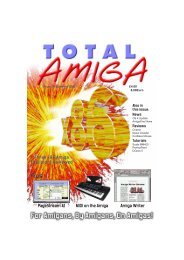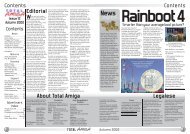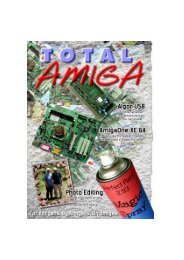Download issue 8 - Total Amiga Magazine
Download issue 8 - Total Amiga Magazine
Download issue 8 - Total Amiga Magazine
- No tags were found...
You also want an ePaper? Increase the reach of your titles
YUMPU automatically turns print PDFs into web optimized ePapers that Google loves.
14FEATURESNetworkingGetting computers to communicate can be tough butthe results are worth it. Robert Williams gets stuck in.Many people now have severalcomputers, some have acollection of <strong>Amiga</strong>s andothers a mixed bag of different platforms.If you have more than onemachine it is useful to be able to moveinformation between them, for smallamounts of data or occasional useswapping floppies, ZIP disks or CD-RWsis probably fine. If you want to move informationaround on a regular basis anetwork makes life much easier andsome types of network also offer thepossibility of sharing other resourcessuch as an internet connection or printersbetween machines as well assimply files.Most networks consist of three discreetparts (I’m simplifying here but the threeelements I describe are the ones a userhas to think about) , the hardware whichphysically links the computers together,the networking software which allowsthem to communicate and applicationsoftware which actually uses the networkconnection. On many simpler networksthe networking software is alsothe application software, it establishescommunication and includes variousservices such as file transfer. More complexnetworks use networking softwaresuch as a TCP/IP stack to enable communicationthen separate applicationsoftware like a web browser or FTPclient uses this connection to send andreceive data across the network. In thisfeature I will look at each of theseelements in turn.HardwareSerialProbably the lowest cost and simplestway to connect two computers is viatheir serial ports, the vast majority ofcomputers have a serial port complyingto the RS232 standard and thereforecan be connected in this way. To makethis connection you need a null modemserial cable which is a standard cableavailable at most computer shops andsuppliers such as Maplin Electronics.Note that a null modem cable is not thesame as the cable used to connect amodem or other serial equipment.<strong>Amiga</strong>s have a 25 pin “D” serial portwhere as most recent PCs (and someother machines) have a 9 pin “D” portboth these ports have the same connectionsso all you need is a null modemcable with the appropriate connectors,you can also buy adaptors from a 25 toa 9 pin port and vice versa. Two types ofnull modem cable are available, threewire and seven wire, the advantage of aseven wire cable is that you can usehardware flow control (also calledRTS/CTS flow control). With a three wirecable (send, receive and ground) codes(called Xon/Xoff) within the data streamare used by each machine to tell theother when it has data to send and whenit is ready to receive data. A seven wirecable has Ready to Send and Clear toSend lines allowing the flow of data tobe controlled through hard ware whichimproves performance and reliability.The maximum length for a good qualityseven wire null modem cable is about15 meters, longer lengths may work butyou are more likely to encounter errorsas the length increases.There are two main limitations to a serialconnection, firstly it is a point to pointconnection, unless you have machineswith multiple free serial ports you canonly link two machines at a time. Thesecond limitation is that serial transfersare slow, the maximum speed of the<strong>Amiga</strong>’s internal serial port is 115200B/s(bits per second) which equates to about14kb/s (kilo bytes per second) beforeany network overhead is taken into account,this is much slower than even afloppy disk drive, transferring a 1Mb filewould take about 1.5 minutes over thisconnection.A serial connection is a cheap way toconnect two computers of almost anytype however it is only really suitable forsmall amounts of data or occasionallytransferring large amounts when you’reprepared to wait.ExplainedParallelWhile the parallel port wasn’t reallydesigned with networking in mind (manyearly personal computers had a parallelport that could only send data) there areseveral systems available which allowyou to link two <strong>Amiga</strong>s or an <strong>Amiga</strong> anda PC using this port. All systems usingthe parallel port use a custom parallelcable such as a ParNET cable (this wasoriginally designed for use with ParNETbut is now also used by other parallelnetworking software such as ProNET) ora laplink cable (also called a “null printer”cable). Never connect the parallelports of two computers using a straightthrough cable as this can causedamage, always ensure you are using acable wired for parallel networking.A parallel connection is usually considerablyfaster than a serial connectionat about 40-60kb/s meaning our 1Mb filewould transfer in around 20 seconds.Cable length is limited to about 5m,again you may be able to get away witha longer cable but you risk data corruption.As the parallel port is implementeddifferently on different computers andoperating systems parallel networking isnot as universal as serial, there tends tobe a specific software and cable com-Network TopologiesHUBPoint to Point:Two devicesdirectly connected.Chain:Each device isconnected to thenext making aingle chain.Star:Each device isconnected to acentral hub.CLUBBED - Issue 8bination required to link to your <strong>Amiga</strong> toeach other platform.If you have two machines which supportparallel networking and are locatedclose together then it is considerablyfaster than serial.EthernetEthernet is the most common dedicatednetworking standard, you will find it inmost companies, businesses, homesand schools connecting anything fromtwo to thousands of computers. Thereare various types of Ethernet identifiedby their speed (in Megabits per second)and the type of cable used to connectthe devices (usually computers but youcan also connect some printers,cable/ADSL modems and various networkdevices directly to an Ethernet network)on the network. Each device isconnected to the network, if the computeror device does not have anEthernet port built in then a NetworkInterface Card (NIC) has to be added.There are two common layouts (alsocalled topologies) for an Ethernet network,a star or a chain. In a star topologyeach device is connected to a centralhub, when one device sends amessage the hub then broadcasts themessage to all the connected devices,for this reason hubs are sometimescalled repeaters or concentrators. Withthe chain topology each device is connectedto another forming a daisy chain,as all the devices are connected to thesame cable a message sent by onedevice is seen by all the others withoutthe need for a hub. A chain topology isusually cheaper to set up because itdoes not require a hub and generallyneeds less cable however it has the disadvantagethat disconnecting onedevice from the network breaks thechain and stops some devices accessingthe rest of the network until the chainis restored. On a star network eachdevice is independent of all the othersand can be disconnected at will. In largenetworks a star based topology haseven more advantages because it iseasier to troubleshoot and expand butthis is beyond the scope of this feature.So let’s take a look at the various typesof Ethernet network available to the<strong>Amiga</strong> user, in this section I will onlymention the most common types used inhome and small business networking.10BaseTA 10BaseT Ethernet network runs at10MB/s (just over 1 Megabyte persecond) using Unshielded Twisted Pair(UTP) cables and must use a star networktopology if there are more than twonetwork devices. UTP cables have eightwires arranged as four pairs twistedtogether which helps reduce interference,removing the need for anyshielding. RJ45 connectors (similar totelephone connectors) are used to connectthe UTP cable to each device. Twodevices can be connected directly usinga UTP cross over cable (the send andreceive lines are crossed) but if morethan two devices need to be connectedthen a hub must be used, devices areconnected to the hub using patch cableswhich are connected straight through(not crossed). 10BaseT hubs start ataround £20 for a unit with 4 UTP ports,much larger ones are available and hubscan be cascaded (by linking one toanother) up to 4 deep. 10BaseTEthernet networks are by far the mostpopular and you will find that suitablehardware is very readily and cheaplyavailable, most current computers (bethey PCs, Macs, Unix boxes etc.) comewith at least a 10BaseT NIC built in, andif not PCI NICs are available verycheaply (from about £10).10Base2A 10Base2 network also runs at 10MB/sbut uses 58 ohm coaxial cable (similar inconstruction to a TV aerial lead) whichconnects to each device using a BNCconnector (this is a coaxial connectorwith a locking ring to prevent accidentaldisconnection). A 10Base2 networkmust use the chain topology with eachmachine connected to another. To dothis each device has a “T” adaptor connectedto its BNC connector and a cableto another machine on the chain is connectedto each “arm” of the “T”. On thedevice at the each end of the chain a50ohm terminator must be connected tothe empty leg of the “T” adaptor, theseterminators are required even if thereare only two machines on the network.For the reasons set out in the sectionabove 10Base2 networks are becomingless popular and 10BaseT (and fastersystems based on the same type of cabling)now dominate the market.However many older Ethernet cardsonly have a BNC connector for10Base2, if you would like to connectthis type of card to a 10BaseT networkmany hubs are available with UTP portsand a BNC connector which can beused to hook up one or more deviceswith 10Base2 connections chainedtogether.FEATURES100BaseT and 1000BaseT(GigaBit)100BaseT and 1000BaseT (alsoreferred to as Gigabit Ethernet) arefaster Ethernet implementations whichtransfer date at 100MB/s and 1000MB/srespectively using UTP cables. To myknowledge no Ethernet cards supportingthese standards have ever beenreleased for the <strong>Amiga</strong>. While 10BaseTis still by far the most common standard100BaseT is becoming more popularwhile 1000BaseT is still very rare outsideserver installations. Many Ethernetdevices capable of 100MB/s operationalso support 10MB/s and are commonlylabelled 10/100, however if you connecta 10MB device to a 100MB network thewhole network has to slow down to thespeed of the slower device.SwitchesOne way to avoid slowing down a100MB network when you add a 10MBdevice is to use a 10/100MB switch insteadof a hub. A switch is similar to ahub in that network devices connect to itin a star topology but instead of broadcastingeach packet of data to everydevice on the network a switch examinesthe packet and only sends it tothe device it is intended for. This allowseach device on the network to run at itsmaximum speed as it is effectively talkingdirectly to one other device at a time.This is really only a side effect of aswitch as its main purpose is to reducenetwork congestion and to allow alldevices to run full duplex (they can sendand receive at the same time) whichalso improves performance.You’re NICedEthernet Network Interface cards havebeen made for almost every model of<strong>Amiga</strong> (yes, even the A500!), if you havea machine with Zorro slots quite a widevariety of Zorro II Ethernet cards havebeen available and one or two can stillbe found new (see table on the nextpage). As usual the Zorro cards tend tobe fairly expensive this means thatsecond hand prices have also remainedquite high. If you’re looking to buysecond hand be aware that many olderZorro cards do not have a UTP connectorso you’ll need to make sure theycan be integrated into your network.A1200 and A600 users can get aPCMCIA Ethernet card, a freewaredriver called cnet.device exists whichsupports a variety of cards which complywith the NE2000 standard, this meansSummer 2001 15




